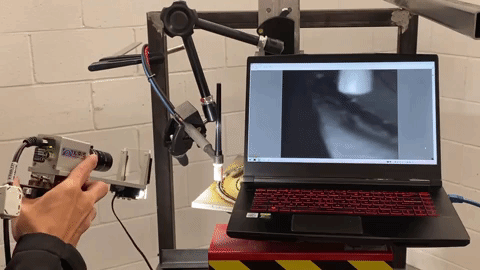A few weeks ago, we held our largest webinar yet: Xiris Weld Cameras for Educators. Our team consisting of our education account manager along with our subject matter expert, hosted the webinar to discuss using Xiris weld cameras in education and training settings. In order to illustrate the ease of use of integrating a weld camera into a weld process, our team did a live demonstration of setting up the Xiris camera used in education settings to playback a live weld in our new welding lab. If you are unfamiliar with weld cameras, we have summarized our explanation from the webinar below, or you can contact one of our experts to learn more.
A Xiris weld camera is a High Dynamic Range (HDR) camera that can see an enormous range of light. This allows you to see all the details of the brightest aspects of the weld arc and melt pool, as well as the darker immediate background. Weld cameras are a particularly great tool for a weld teaching or training setting as it allows you to:
- Record and playback any open arc process at any angle;
- Use a large display to playback live welds so that students don’t have to crowd around a booth;
- Build a video library of example welds, whether good or bad;
- Record good welds, bad welds for classroom teaching;
- Playback a weld video in slow motion;
- Use the videos for online teaching programs such as Canvas, Teams and Zoom;
- Remotely review or grade a student's weld

Request access to a copy of the on-demand webinar and watch the full video of our team setting up the weld camera to capture a live weld.
Our experts often get many questions every day about weld cameras and their features that make them beneficial. Here are some of those questions that we received during the Q&A session of our webinar, along with our answers based on years of experience.
1. What is the benefit of changing optics versus a digital zoom feature?
Changing optics allows for more flexibility. With changing optics, you are able to change the working distance and field of view at will. Changing optics will also preserve the quality of the video compared to using digital zoom.
2. Can the camera move along the joint for hand welding instead of remaining stationary?
Yes, the camera can move along a joint to capture hand welds. Some schools will mount the camera to a track system and have the weld camera move along with the student. This can be good for especially long welds while maintaining a nice close up shot of the process.
3. How hot can the camera get?
The camera can be in ambient air temperatures of up to 100 degrees Fahrenheit before it needs cooling. With cooling, it can go up to 300 degrees Fahrenheit. It can also withstand even higher temperatures with our high temp cooling kit. We actually put our camera to the test on a BBQ without failure! Check that story out here.
Check out the full video to get more answers to our most frequently asked questions such as:
- Do most schools run two cameras? One at the weld and one from further away?
- Why won’t a traditional/off the shelf camera work?
- What is the difference between a mono and colour camera?
We hope you enjoy the on-demand webinar and find it informative. Contact us if you have any other questions that were not answered in the webinar or if you would like to discuss more.
To stay up to date, follow us on social media or subscribe to our blog!






